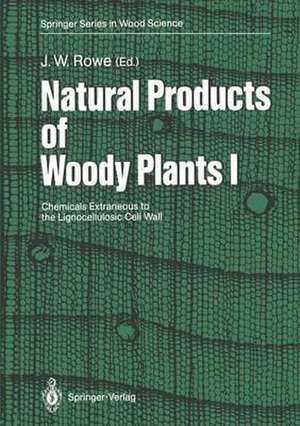Natural Products of Woody Plants: Chemicals Extraneous to the Lignocellulosic Cell Wall: Springer Series in Wood Science
Editat de John W. Roween Limba Engleză Paperback – 19 ian 2013
Din seria Springer Series in Wood Science
- 18%
 Preț: 1543.84 lei
Preț: 1543.84 lei - 23%
 Preț: 2062.76 lei
Preț: 2062.76 lei - 18%
 Preț: 1824.32 lei
Preț: 1824.32 lei - 24%
 Preț: 817.72 lei
Preț: 817.72 lei - 18%
 Preț: 1225.16 lei
Preț: 1225.16 lei - 18%
 Preț: 3288.92 lei
Preț: 3288.92 lei - 18%
 Preț: 948.29 lei
Preț: 948.29 lei - 18%
 Preț: 1222.31 lei
Preț: 1222.31 lei - 18%
 Preț: 2093.60 lei
Preț: 2093.60 lei - 18%
 Preț: 946.87 lei
Preț: 946.87 lei - 15%
 Preț: 643.34 lei
Preț: 643.34 lei - 18%
 Preț: 1122.87 lei
Preț: 1122.87 lei - 18%
 Preț: 1020.30 lei
Preț: 1020.30 lei - 24%
 Preț: 836.42 lei
Preț: 836.42 lei - 20%
 Preț: 569.49 lei
Preț: 569.49 lei - 15%
 Preț: 638.89 lei
Preț: 638.89 lei - 15%
 Preț: 636.30 lei
Preț: 636.30 lei - 15%
 Preț: 635.31 lei
Preț: 635.31 lei - 18%
 Preț: 878.05 lei
Preț: 878.05 lei - 15%
 Preț: 646.43 lei
Preț: 646.43 lei - 18%
 Preț: 1004.67 lei
Preț: 1004.67 lei - 18%
 Preț: 894.03 lei
Preț: 894.03 lei - 15%
 Preț: 658.70 lei
Preț: 658.70 lei - 15%
 Preț: 641.53 lei
Preț: 641.53 lei - 18%
 Preț: 950.84 lei
Preț: 950.84 lei - 18%
 Preț: 783.35 lei
Preț: 783.35 lei - 15%
 Preț: 645.79 lei
Preț: 645.79 lei -
 Preț: 388.13 lei
Preț: 388.13 lei - 18%
 Preț: 780.82 lei
Preț: 780.82 lei - 15%
 Preț: 529.13 lei
Preț: 529.13 lei
Preț: 880.81 lei
Preț vechi: 1158.96 lei
-24% Nou
Puncte Express: 1321
Preț estimativ în valută:
168.58€ • 181.97$ • 141.36£
168.58€ • 181.97$ • 141.36£
Carte tipărită la comandă
Livrare economică 14-21 aprilie
Preluare comenzi: 021 569.72.76
Specificații
ISBN-13: 9783642740770
ISBN-10: 3642740774
Pagini: 1316
Ilustrații: LXII, 1243 p. 27 illus. In 2 volumes, not available separately.
Dimensiuni: 170 x 242 x 69 mm
Ediția:1989
Editura: Springer Berlin, Heidelberg
Colecția Springer
Seria Springer Series in Wood Science
Locul publicării:Berlin, Heidelberg, Germany
ISBN-10: 3642740774
Pagini: 1316
Ilustrații: LXII, 1243 p. 27 illus. In 2 volumes, not available separately.
Dimensiuni: 170 x 242 x 69 mm
Ediția:1989
Editura: Springer Berlin, Heidelberg
Colecția Springer
Seria Springer Series in Wood Science
Locul publicării:Berlin, Heidelberg, Germany
Public țintă
ResearchCuprins
1 Introduction and Historical Background.- 1.1 Historical Uses of Extractives and Exudates.- 1.2 Natural Products Chemistry — Past and Future.- 2 Fractionation and Proof of Structure of Natural Products.- 2.1 Introduction.- 2.2 Novel Techniques and Recent Developments in Fractionation and Isolation.- 2.3 Nuclear Magnetic Resonance Spectroscopy.- 2.4 Other Spectroscopic Techniques.- 2.5 General Conclusions.- References.- 3 Evolution of Natural Products.- 3.1 Convergent Synthesis and the Origin of RNA-Based Life.- 3.2 Expansion of the Acetate, Mevalonate, and ?-Aminolevulinate Pathways in Bacteria and Algae.- 3.3 Expansion of the Shikimate Pathway in Terrestrial Plants.- 3.4 Phytochemistry and Plant Defense.- 3.5 Oxidation Levels of Angiospermous Micromolecules.- 3.6 Skeletal Specialization of Angiospermous Micromolecules.- 3.7 Quantification of Micromolecular Parameters.- 3.8 Phytochemical Gradients in Angiosperms.- 3.9 Future Perspectives.- References.- 4 Carbohydrates.- 4.1 Introduction.- 4.2 Sucrose.- 4.3 Higher Oligosaccharides Related to Sucrose.- 4.4 Other Oligosaccharides.- 4.5 Monosaccharides.- 4.6 Alditols.- 4.7 Cyclitols.- 4.9 Starch.- 4.10 Extractable Polysaccharides.- References.- 5 Nitrogenous Extractives.- 5.1 Amino Acids, Proteins, Enzymes, and Nuccleic Acids.- 5.2 The Alkaloids.- 6 Aliphatic and Alicyclic Extractives.- 6.1 Simple Organic Acids.- 6.2 Complex Aliphatic and Alicyclic Extractives.- 6.3 Fats and Fatty Acids.- 6.4 Chemistry, Biochemistry, and Function of Suberin and Associated Waxes.- 7 Benzenoid Extractives.- 7.1 Monoaryl Natural Products.- 7.2 Gallic Acid Derivatives and Hydrolyzable Tannins.- 7.3 Lignans.- 7.4 Stilbenes, Conioids, and Other Polyaryl Natural Products.- 7.5 Flavonoids.- 7.6 Biflavonoids and Proanthocyanidins.- 7.7 CondensedTannins.- 8 Isoprenoids.- 8.1 Terpenoids.- 8.2 Steroids.- 9 The Influence of Extractives on Wood Properties and Utilization.- 9.1 Contribution of Extractives to Wood Characteristics.- 9.2 Role of Wood Exudates and Extractives in Protecting Wood from Decay.- 9.3 Effect of Extractives on Pulping.- 9.4 Effect of Extractives on the Utilization of Wood.- 9.5 Health Hazards Associated with Extractives.- 10 The Utilization of Wood Extractives.- 10.1 Naval Stores.- 10.2 Gums.- 10.3 Significance of the Condensed Tannins.- 10.4 Rubber, Gutta, and Chicle.- 10.5 Other Extractives and Chemical Intermediates.- 10.6 Pharmacologically Active Metabolites.- 11 The Future of Wood Extractives.- 11.1 Introduction.- 11.2 Requirements for Future Wood Extractives Ventures.- 11.3 Prospects for Existing Extractives-Based Industries.- 11.4 Failed Wood Extractives Ventures.- 11.5 Future Directions for Industrially Oriented Extractives Research.- 11.6 Areas of Needed Basic Research.- 11.7 Conclusions.- References.- Index of Plant Genera and Species.- Organic Compounds Index.










